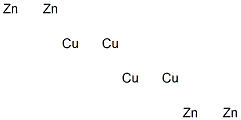Usage And Synthesis
Orgotein is the
name applied to a group of metalloproteins obtained from various tissuesources,
such as hemolyzed plasma-free bovine erythrocytes or beef liver. They are
copper – zinc/protein chelates with molecular
masses of about 34 000. These compounds have
potent superoxide dismutase activity. When administered directly into the joint at 4 mg/week
for 6weeks, marked improvement in the mobility of acute rheumatoid patients occurred.
Synovial fluid levels of rheumatoid factor and
prostaglandin E2 were reduced.
Fresh beef blood was centrifuged, e.g., at about 2,600 to 5,000 x g for 10 minutes at 0°C and the plasma decanted. The red blood cells were then washed at least twice and preferably repeatedly with 2 to 3 volumes of 0.9% saline solution. The washed red blood cells were lysed by mixing with 1.1 volumes of cold deionized water containing 0.02% detergent (Saponin). After a minimum of 30 minutes at 4°C with stirring, 0.25 volume (per volume of hemolysate) of ethyl alcohol at -15°C was slowly added while stirring followed by 0.31 volume (per volume of hemolysate) of chloroform, also at -15°C. Stirring was continued for about 15 minutes at -5°C or below, at which time, the mixture was a thick paste. The hemoglobin precipitation was carried out in a cold bath which was kept at below -10°C. After the paste had stood for a further 15 minutes at 4°C, 0.2 volume of cold 0.15 M NaCl solution was added, giving an easily poured suspension. The precipitate and excess chloroform were removed by centrifuging at about 12,000 to 20,000 x g at about -10°C for 10 minutes. The supernatant liquid was removed and if desired, filtered and briefly dialyzed against cold-deionized water, prior to lyophilization.
The alcohol chloroform precipitate was dislodged, chloroform was removed, the pellet broken up and reextracted with about an equal amount of deionized water by blending the precipitate and the water in a blender and thereafter centrifuging. The reextraction solution was dialyzed and lyophilized with the main extract. If the process proceeds normally, the reextraction of the precipitated hemoglobin usually yields up to 30% of protein mixture present in the original supernatant. An additional reextraction may give an additional The lyophilized material was redissolved in 0.025 M tris-glycine buffer containing 0.001 M Mn2+ at pH 7.5 (usually to a concentration of 20 mg/ml). The solution was heated at or near 65°C for about 15 minutes. This step removes the carbonic anhydrase and other heat labile proteins from the solution. After heating, the solution was rapidly cooled in an ice bath to 5°C. The solution was then centrifuged at 20,000 x g at 0°C for 10 minutes to remove the precipitate. Filtration through "Versapore" works equally well. The supernatant was thoroughly dialyzed against deionized water to remove excess metal ions and buffer and then lyophilized. The resulting solid consists largely of orgotein.
The alcohol chloroform precipitate was dislodged, chloroform was removed, the pellet broken up and reextracted with about an equal amount of deionized water by blending the precipitate and the water in a blender and thereafter centrifuging. The reextraction solution was dialyzed and lyophilized with the main extract. If the process proceeds normally, the reextraction of the precipitated hemoglobin usually yields up to 30% of protein mixture present in the original supernatant. An additional reextraction may give an additional The lyophilized material was redissolved in 0.025 M tris-glycine buffer containing 0.001 M Mn2+ at pH 7.5 (usually to a concentration of 20 mg/ml). The solution was heated at or near 65°C for about 15 minutes. This step removes the carbonic anhydrase and other heat labile proteins from the solution. After heating, the solution was rapidly cooled in an ice bath to 5°C. The solution was then centrifuged at 20,000 x g at 0°C for 10 minutes to remove the precipitate. Filtration through "Versapore" works equally well. The supernatant was thoroughly dialyzed against deionized water to remove excess metal ions and buffer and then lyophilized. The resulting solid consists largely of orgotein.
Palosein Veterinary (Oxis), Ontosein (Tedec-Meiji,
Spain), Peroxinorm (Gr¨unenthal, Austria),
Serosod (Serono, Italy).
Orgotein, bovine superoxide dismutase with anti-inflammatory
activity, was introduced in 1968 for the management of rheumatic disorders and for the amelioration of side-effects of radiotherapy. Although not widely registered, it
remains available in other countries.
Preparation Products And Raw materials
Raw materials
Related Product Information
- TRIS(2,2,6,6-TETRAMETHYL-3,5-HEPTANEDIONATO)DYSPROSIUM(III)
- 1,1,3,3-TETRAMETHYLBUTYL ISOCYANIDE
- Tosylmethyl isocyanide
- Aluminum acetylacetonate
- DICHLORO(ETHYLENEDIAMINE)PLATINUM(II)
1of4
PROMPT×
PROMPT
The What'sApp is temporarily not supported in mainland China
The What'sApp is temporarily not supported in mainland China
Cancel
Determine
